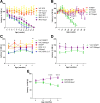Intrabody gene therapy ameliorates motor, cognitive, and neuropathological symptoms in multiple mouse models of Huntington's disease
- PMID: 19864571
- PMCID: PMC2822643
- DOI: 10.1523/JNEUROSCI.4286-09.2009
Intrabody gene therapy ameliorates motor, cognitive, and neuropathological symptoms in multiple mouse models of Huntington's disease
Abstract
Huntington's disease (HD) is an autosomal dominant neurodegenerative disease resulting from the expansion of a glutamine repeat in the huntingtin (Htt) protein. Current therapies are directed at managing symptoms such as chorea and psychiatric disturbances. In an effort to develop a therapy directed at disease prevention we investigated the utility of highly specific, anti-Htt intracellular antibodies (intrabodies). We previously showed that V(L)12.3, an intrabody recognizing the N terminus of Htt, and Happ1, an intrabody recognizing the proline-rich domain of Htt, both reduce mHtt-induced toxicity and aggregation in cell culture and brain slice models of HD. Due to the different mechanisms of action of these two intrabodies, we then tested both in the brains of five mouse models of HD using a chimeric adeno-associated virus 2/1 (AAV2/1) vector with a modified CMV enhancer/chicken beta-actin promoter. V(L)12.3 treatment, while beneficial in a lentiviral model of HD, has no effect on the YAC128 HD model and actually increases severity of phenotype and mortality in the R6/2 HD model. In contrast, Happ1 treatment confers significant beneficial effects in a variety of assays of motor and cognitive deficits. Happ1 also strongly ameliorates the neuropathology found in the lentiviral, R6/2, N171-82Q, YAC128, and BACHD models of HD. Moreover, Happ1 significantly prolongs the life span of N171-82Q mice. These results indicate that increasing the turnover of mHtt using AAV-Happ1 gene therapy represents a highly specific and effective treatment in diverse mouse models of HD.
Figures









References
-
- Arrasate M, Mitra S, Schweitzer ES, Segal MR, Finkbeiner S. Inclusion body formation reduces levels of mutant huntingtin and the risk of neuronal death. Nature. 2004;431:805–810. - PubMed
-
- Auricchio A, Kobinger G, Anand V, Hildinger M, O'Connor E, Maguire AM, Wilson JM, Bennett J. Exchange of surface proteins impacts on viral vector cellular specificity and transduction characteristics: the retina as a model. Hum Mol Genet. 2001;10:3075–3081. - PubMed
-
- Bankiewicz KS, Forsayeth J, Eberling JL, Sanchez-Pernaute R, Pivirotto P, Bringas J, Herscovitch P, Carson RE, Eckelman W, Reutter B, Cunningham J. Long-term clinical improvement in MPTP-lesioned primates after gene therapy with AAV-hAADC. Mol Ther. 2006;14:564–570. - PubMed
-
- Bartlett JS, Samulski RJ, McCown TJ. Selective and rapid uptake of adeno-associated virus type 2 in brain. Hum Gene Ther. 1998;9:1181–1186. - PubMed
-
- Behrends C, Langer CA, Boteva R, Böttcher UM, Stemp MJ, Schaffar G, Rao BV, Giese A, Kretzschmar H, Siegers K, Hartl FU. Chaperonin TRiC promotes the assembly of polyQ expansion proteins into nontoxic oligomers. Mol Cell. 2006;23:887–897. - PubMed
Publication types
MeSH terms
Substances
Grants and funding
LinkOut - more resources
Full Text Sources
Other Literature Sources
Medical
